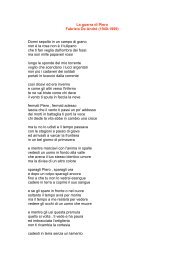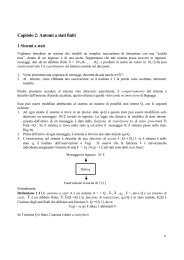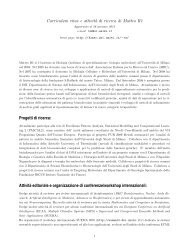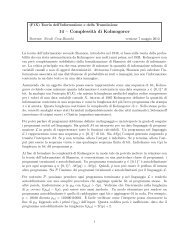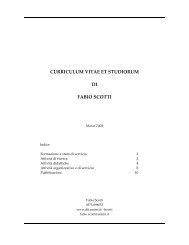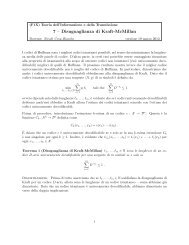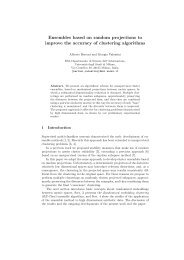La formula di Eulero (1765) - Binet (1843) ricavata elementarmente
La formula di Eulero (1765) - Binet (1843) ricavata elementarmente
La formula di Eulero (1765) - Binet (1843) ricavata elementarmente
You also want an ePaper? Increase the reach of your titles
YUMPU automatically turns print PDFs into web optimized ePapers that Google loves.
4) In conclusione, f(n) = Θ(Φ n ), e anche f(n) = ⎣0.5 + Φ n /√5⎦, dato che<br />
|Φ' n | < 1, Φ' n → 0 e i segni si alternano.<br />
5) Come mai 1/√5 (Φ n – Φ' n ) è sempre esattamente intero? A causa<br />
dell'equazione (**) Φ 2 = Φ + 1, che conviene interpretare come riscrittura<br />
Φ 2 → Φ + 1. Quin<strong>di</strong><br />
Φ 3 = Φ 2 · Φ = (Φ + 1) · Φ = Φ 2 + Φ = (Φ + 1) + Φ = 2 Φ + 1,<br />
Φ 4 = Φ 3 · Φ = (2 Φ + 1) · Φ = 2 Φ 2 + Φ = 2 (Φ + 1) + Φ = 3 Φ + 2, …<br />
in generale Φ n = x Φ + y con x e y interi positivi (che, per inciso, sono<br />
numeri <strong>di</strong> Fibonacci consecutivi), e la stessa cosa vale per l'altra soluzione<br />
<strong>di</strong> (**), Φ' n = x Φ' + y, con gli stessi interi x e y.<br />
Ne consegue che Φ n – Φ' n = x Φ + y – (x Φ' + y) = x (Φ – Φ') = x√5 e<br />
quin<strong>di</strong> che 1/√5 (Φ n – Φ' n ) = x è intero (e x = f(n)).<br />
6) L'equazione (**) può essere interpretata come Φ → 1 + 1/Φ e iterando<br />
questa riscrittura abbiamo Φ = 1 + 1/Φ = 1 + 1/(1 + 1/Φ) =<br />
1 + 1/(1 + 1/(1 + 1/Φ)) = … che esprime Φ come una frazione continua<br />
con infiniti quozienti tutti uguali a 1 (si veda, per esempio, la pagina web<br />
http://www.math.unifi.it/~mugelli/promat/<strong>di</strong>ofanto/fracont.htm).<br />
Interpretando invece (**) come Φ → √(1 + Φ) otteniamo<br />
Φ = √(1 + Φ) = √(1 + √(1 + Φ)) = √(1 + √(1 + √(1 + Φ))) = …,<br />
un altro modo <strong>di</strong> ottenere il rapporto aureo…


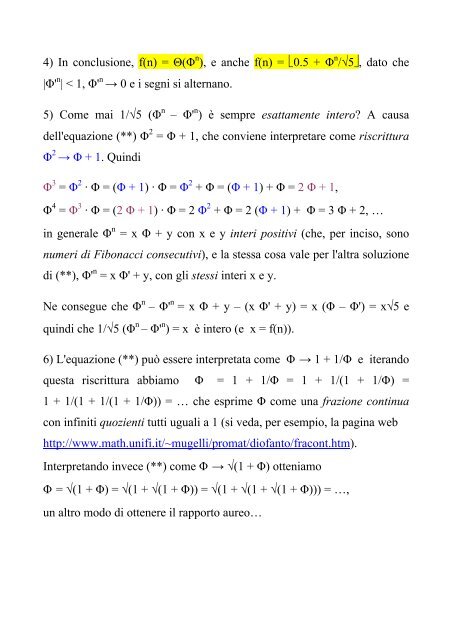
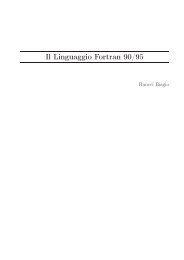
![1) [4] Cos'è un hazard? Uno stallo? Cos'è una pipeline multiple ...](https://img.yumpu.com/16431383/1/190x245/1-4-cose-un-hazard-uno-stallo-cose-una-pipeline-multiple-.jpg?quality=85)
